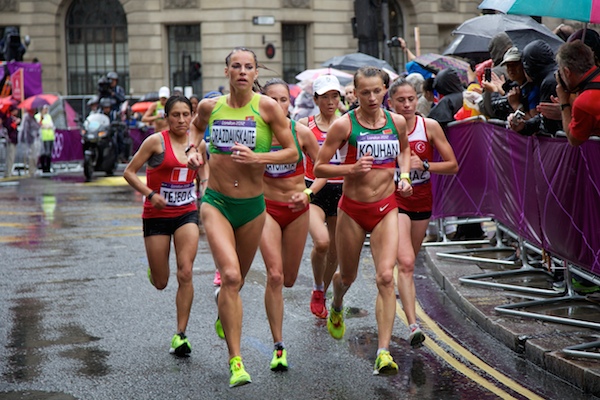Dear Sports Fan,
I was watching the Boston Marathon this year and the announcers talked about how difficult the chilly, drizzly weather was for runners. I thought that weather would have been good for running. What’s up with that? What are ideal conditions for a marathon?
Thanks,
Cathy
Dear Cathy,
The weather for the Boston Marathon this year was between 40 and 50 degrees Fahrenheit with light rain and a 14 mph ESE wind. That’s not ideal, but mostly because of the wind. Temperature and wind are the two main factors that effect running with precipitation a distant third. These factors affect elite runners and normal runners (if we can call anyone who is able to run 26.2 miles, normal) differently. We’ll go into each one of the factors separately but for the TL:DR crew, the ideal conditions are cool, dry, and depending on the course, either still or with wind pushing the runners from behind.
When I think about my ideal temperature for running, I think of a nice day somewhere in the high 60s. Not hot enough to be uncomfortable but not cold enough to make you want to bundle up or hang out inside eating Cheetos and watching TV. It turns out that I’m wrong, or at least, people who run marathons don’t share my Cheeto eating proclivities. The ideal temperature for marathon running is pretty much what we had for the Boston Marathon this year. According to the New York Times the best temperature range for marathoning is between 41 and 50 degrees Fahrenheit. For every five degrees of warmth above that, elite marathoners slowed down by an average of .4 percent. The effect of heat on normal runners is around double that on elite runners, perhaps because “slower runners spend more time on the course, and the temperature generally rises through the day. Or it could be because slower runners tend to run with a larger pack. A tightly clustered group of runners generates heat and blocks it from dissipating.”
Wind is, perhaps, even a bigger factor than temperature. As you might expect, running with the wind at your back makes you faster, while running into the wind makes you slower. What you might not expect is that the effect is not even. Not even close. A headwind slows down a runner much, much more than a tailwind helps a runner. Many marathon courses have runners moving in all four directions over the 26 miles. When running on one of these courses, unless you were to get freakishly lucky and have the wind change direction to support you four times during the day, you’d be better off having no wind. The Boston Marathon is not like that — its course is pretty much a straight line traveling Northeast from Hopkinton to downtown Boston. This means that the wind is going to be a constant battle or boon all day. A few years ago, Geoffrey Mutai won the race with a time of 2:03:02 which would have smashed the World Record but wasn’t eligible because he was running with a tailwind of 15 to 20 miles per hour the whole way. In fact, the Boston Marathon is not eligible for World Records at all because it only travels in one direction. This year, that ESE wind was neither a true headwind or a tailwind. For most of the race, it would have been simply pushing runners left and forcing them to lean a little to keep going straight. Over the final five miles or so though, the course goes a little bit closer to due East where the wind would have been mostly a headwind, slowing the runners’ progress.
Precipitation, unless it is severe enough to threaten footing, or in Boston this winter, the ability to see over the snowbanks, is normally only a factor because of its effect on how people experience temperature. All the studies that I saw on temperature and marathon running actually weren’t about temperature, they were about “WGBT” or “wet bulb globe temperature.” This is one of those measures, like wind chill or heat index that attempts to more accurately measure what the weather feels like in a single number. Precipitation makes it feel colder, whether it’s rain on an 85° day or snow on a 30° day. On a day like this past Monday, when the raw temperatures were already ideal for marathon running, the rain was an unnecessary distraction. If it had been 10 degrees warmer, the rain would actually have helped the runners.
Thanks for your question,
Ezra Fischer

